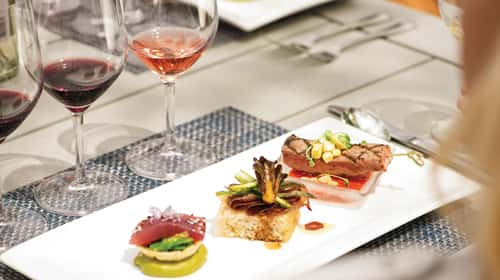When all of us first began enjoying wine in adulthood, we heard the same old chestnut: white wine with fish, red wine with meat. It was a rule destined to be broken, if not seriously twisted like a corkscrew.
“Sometimes people just want to eat and drink and not think about if it’s the ‘correct’ wine or not. They don’t want the education, they just want to enjoy themselves,” says Sondra Bernstein, who should know. She’s the proprietor of the girl & the fig restaurant in Sonoma, celebrating 22 years in business this year.
Bernstein’s restaurant specializes in serving Rhône-style wines, which includes Grenache, Syrah, Cinsault, Viognier, and Roussanne, among others. “One of the reasons we went with Rhône wines is because they are very food-friendly. Both the acids and the tannins are not crazy high, so they have a nice balance. Many different foods pair well with them.”
Brian Casey, a sommelier at Fairmont Sonoma Mission Inn & Spa, says he is happy to discuss winemaking techniques such as malolactic fermentation with guests, but they usually seek a simple explanation. “I can get into all the geeky wine stuff during their meal, but basically I tell them that malolactic fermentation is like turning lemon juice into milk.
“For the most part, the wine industry has done a terrible job of demystifying wine, and as a result many diners come to the restaurant intimidated by it. And when people are intimidated, they tend to not ask questions because they don’t want to appear uneducated about wine. It’s my job to make it accessible and to help them pair wines with their meal.”
Casey is introductory level of the Court of Master Sommeliers, which means he has a general knowledge of not only wine but also spirits, sake, beer, or any alcohol being served. “The sommelier is a pivotal person in a restaurant. The food servers have to go through a specific sequence of tableside duties, but the sommelier has more fun, popping in on diners and answering questions. We also have a responsibility to make diners feel comfortable.”
Generally, there’s a lot of juxtaposing in pairing wine with food, says Casey, such as matching acid with acid. “A baked potato with bleu cheese on top would pair great with a Syrah that has hints of black pepper, for instance. Drinking the Syrah with the cheese is almost like adding another topping on the potato.”
The food science of pairings
Marc Golick is responsible for the wine-and-food pairings that take place just about every other Saturday year-round at V. Sattui Winery in St. Helena, creating seasonal menus closely matched to the most appropriate wines produced by the winery. Up to 24 guests are accommodated at each five-course meal. “There are some pairing rules that we still abide by, but I take pride that we actually teach our guests the food science behind the pairings, much of which is the same as it’s always been,” says Golick. The only ‘new’ factor is probably umami, and it’s more of an experience than a flavor.”
“Our goal is to make wine-and-food pairing easy and fun,” he continues. “We paint a picture for them, demonstrating that pairing doesn’t require that they memorize lots of ingredients. Light bulbs go on when they begin to understand that it’s not complicated.”
Golick cooks up an annual “Elevate Your Tailgate” pairing menu aimed at Super Bowl fans who prefer to drink wine with their munchies instead of beer. A recent Tailgate sampling of V. Sattui wines paired with foods included Prestige Cuvée with sea salt crisps with Fromager D’Affinois (a French cheese similar to brie) topped with smoked bacon and chives. Main nibbles included baby back ribs with an old-vine Zinfandel glaze paired to Crow Ridge Zinfandel, and beef short rib sliders paired to Mt. Veeder Cabernet Sauvignon. The sweet finish was Madeira sipped with a warm brownie ice cream sandwich.
“I get playful with the Tailgate menus at times,” he says. “The Super Bowl is a beer-centric time of the year, so we try to be adventurous and raise it to a new level that stimulates the senses for football fans.”
Making flavors pop
St. Francis Winery & Vineyards near Santa Rosa elevates wine-and-food pairing to an award-winning level, since collecting several honors from Open Table for its special pairings. Offered three times daily, five days a week, the five-course pairing with a constantly evolving menu is created by executive chef Trevor Eliason. “We change the menu one item at a time as our new wines are released and new garden items are ready to harvest,” he explains.
Eliason and his educators begin the pairing experience by first discussing the selection of wines to be served. “Guests should introduce their palate first to the wine. Then we bring in the food. It throws people a curve because they believe the food starts the relationship. Yet wine is very cleansing to the palate, so once we introduce the food elements to enhance the wine, they see how it makes all the difference.”
In choosing wines to pair with food, Eliason puts the wine onto a spectrum. “We’ll see that the texture of a wine and its aromatics are very important, and we want to add food elements that are contrasting or comparable . Either technique can make the flavors pop. When I taste the wines, my brain is ticking off ideas of what to cook to pair with them.”
Many of the St. Francis food ingredients are grown on the winery property in an organic garden within 50 feet of vineyards. “Things that grow together, go together,” says Eliason. On one recent day, for example, a pole bean ragu was served with a 2017 Sangiovese, a wine that’s light on the palate with herbaceous aromatics. The grapes and the beans grew out of the same soil.
“The Sangiovese is a beautiful food wine, well balanced and not too thick, so we paired it with earthy food elements of beans, roasted corn, and chanterelle mushrooms that really brings out the umami. The acid level of the wine opens it up and gives it a bigger mouthfeel,” he says.
The umami factor
Umami has changed the science perspective a little, says Eliason. “It came from the Japanese culture, and people are discovering that every culture has different products that need to be handled correctly. Black garlic is a great example, and some people consider a well caramelized Parmesan cheese as having umami.”
A sample pairings menu at St. Francis might include Chardonnay with sautéed tiger shrimp, or Pinot Noir with roasted baby beets. Reserve Merlot pairs well with fresh bucatini pasta. Zinfandel pairs well with glazed pork tenderloin, and white port with Tahitian vanilla cassata cake.
Eliason says the rules of wine-and-food pairing are more like guidelines than actual rules, meaning you can drink what you like with the food you like. “Everyone’s palate is different.”
Sommelier Casey concurs. “Give 10 glasses of the same wine to 10 people and you’ll get 10 different descriptions and experiences. There is no right or wrong answer.”
For food pairing, Casey says there are some wines that cross all sorts of barriers, such as rosé and sparkling wine. “Chardonnay stored in oak sometimes drinks like a cold red wine, and Pinot Noir can also be like drinking a nice, fruity white. A diner may see that Chardonnay is one of the wines on our pairing menu, but tells me he’s not a Chardonnay fan. Of course we can swap out the Chardonnay for something else.”
Sometimes guests can be put off a bit by the server uniforms and the sommeliers in suits, he admits. “But honestly, I believe the whole pretentiousness that’s been built up around sommeliers is going away. We somms want to have honest conversations with our dinner guests and make them feel comfortable about asking wine questions. We don’t want to come off as stuffy.”
Getting looser with the rules
If diners come to the Fairmont believing they must order a white wine with fish, but prefer drinking reds, there’s always a work-around for Casey. “They can have Chardonnay with a steak prepared with mushrooms and truffle butter, for instance, and we always help people get a little closer to the right match while still keeping the wine a varietal they already like.”
A food-and-wine pairing won’t win you over if you don’t like the chosen wines, says Bernstein. “I happen to like Viognier with scallops, but I would probably like it with something else, too. I’ve gotten a lot looser with ‘rules’ over the years. People should drink what they like regardless of what the food is. That’s when a nice dry Rosé bridges the gap if someone is confused by what wine to order with their meal. Our restaurant sells a huge amount of Rosé—it’s so popular.”
Making guests feel at ease is essential to successful wine-and-food pairings at V. Sattui. “People need it to be accessible, where they don’t fear speaking up and asking questions,” says Golick. “We try to get rid of the pretense and make it fun. It has to be fun. After all, it’s only grape juice, but it’s fantastic grape juice.”





